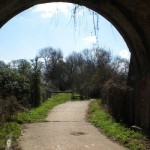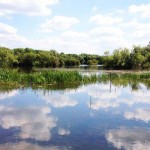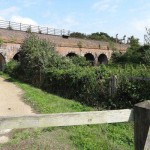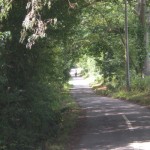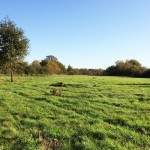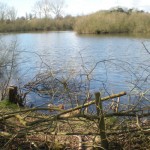Council objects to 75 new dwellings on Park Lane
After several public meetings, and a long discussion at the Extra-ordinary meeting of the Council on 27th November, the Parish Council took the decision to work with a planning consultant, Andrea Pellegram Ltd, to help capture all the points raised by the Councillors in relation to the application 232704, for the proposed erection of up to 75 dwellings with only access to be considered via Park Lane.
There are copied below as well as this downloadable version.
Charvil Parish Council Response to Planning Application 232704, at Land West of Park Lane, Charvil.
1. This response from Charvil Parish Council seeks REFUSAL of an outline planning application made by Hicks Developments Ltd on land west of Park Lane, Charvil for the proposed erection of up to 75 dwellings with only access to be considered via Park Lane (and all other matters reserved).
2. The response raises a number of specific concerns and queries which are addressed under separate headings in the response below. The response also raises questions about the sustainability of Charvil as a location for major housing developments such as that under consideration at present.
Sustainability of Charvil
3. Charvil is not a sustainable location for significant new development. Successive local planning strategies within Wokingham have decided to not allocate significant development in Charvil for the reason that Charvil lacks basic facilities which are needed to support a sustainable settlement. It has a large population supported with relatively few local facilities – there are no health care facilities, the infrequent bus services do not serve Charvil well. There is no library and no post office. There is not the breadth of provision which supports a self-sufficient community.
4. Charvil has one village shop, a petrol filling station, a primary a school, two pubs, playing and sports pavilion, and a community hall. These are the sorts of facilities that support medium sized villages. Facilities are spread out and there is no centre to Charvil where such facilities are concentrated. Undertaking a linked trip to available facilities on foot will involve a long walk, unless you live right by one of the facilities you need.
5. Infrequent bus services are not well used by local residents and are highly unlikely to be used by residents of new developments no matter what Framework Travel Plans try to do. Cycling is not an attractive option owing to the lack of safe cycle lanes on the Old Bath Road. Walking routes along the same road are narrow and incomplete. Residents overwhelmingly drive to nearby Twyford, Reading and other towns to access higher level services and to get to work. This is the reality of the situation, and the proposed development will result in more of the same.
6. For these reasons, the local community are concerned that a further 75 dwellings will result in more pressure on local roads, more queuing to get onto the Old Bath Road and the A4, a more difficult pedestrian environment around the school, and more pressure on limited community facilities. If the planning application is to be consented, then the developers should make a contribution to local community facilities to address the lack of community infrastructure provision in Charvil to demonstrate that this development would not make an existing bad situation worse. This was something the Parish Council would have discussed with the applicant, but it was very clear when informed of the imminent application that plans were set and unchangeable.
Technical Concerns and Queries
Transport
7. The following concerns and queries are raised about the assessment of traffic impacts arising from the proposed development.
8. Traffic Survey date – It has been widely noted that post-pandemic traffic conditions were significantly lighter they are than now, as the after-effects of lockdown continued with high levels of working from home, extended economic inactivity and only a gradual rebound in leisure trips. Additionally, the recent opening of the Elizabeth Line may have encouraged people to drive to Twyford to access this service. Charvil Parish Council has concerns that the traffic survey undertaken in June 2022 is not a realistic portrayal of current and likely future traffic conditions, as a basis for assessment. Very different peak conditions were noted in June 2023 with the SID recording 325 vehicles between 8-9am, 90 vehicles more than the 235 cars recorded by the Hicks survey at a comparable location.
9. Site Access – Charvil Parish Council has reviewed the Road Safety Audit which is limited to the design of the site junction access. The proposed site access position lies between an access junction and exit junction for the car park next to the primary school opposite. The Parish Council has significant concern over the apparent need for vehicles entering and leaving the application site to enter the oncoming traffic lane to complete turning manoeuvres. This is not considered to be a safe arrangement in the context of AM peak traffic flows particularly around school drop off between 08:00 and 09:00 on weekdays. In reality, traffic movements are likely to be highly concentrated within a shorter period within the peak hour for school drop off.
10. Pedestrian Safety on Park Lane – Road safety is an important consideration for pedestrian users of Park Lane and in the context of the morning peak hour traffic, this is particularly important in relation to school children making their way to school opposite the application site. Surveyed traffic conditions from June 2022 (which may be lighter than now as discussed above) indicate 241 passenger car units (pcu) northbound traffic movements in the peak hour and 125 pcu southbound. With higher baseline flows and with development, this would increase to 281 pcu northbound and 149 pcu southbound.
Even ignoring the likely concentration of movements within the short time leading up to school start (which has not been quantified) this equates to 420 vehicles coming one way or the other along Park Lane in the vicinity of the school every 8.4 seconds across the one-hour peak. Within this total 43 vehicles would be entering or leaving the site based on current TRICS calculations, into the narrow Park Lane, in front of the school entrance, in busy traffic conditions.
11. Average vehicle speeds on the site frontage were observed at 27-28mph and 85th percentile speeds were calculated to be 31-32mph. It is argued that this is actually a high average speed given traffic calming measures in place on Park Lane. In the context of increases in general traffic flows and with-development flows, with traffic emerging from the site between the school entrances, this creates a difficult environment for primary school age children to cross Park Lane to get to school. Measures are required to address pedestrian safety for crossing Park Lane.
12. TRICS assumptions – The lack of a range of local shops and services means that residents of the new development will rely to an extent on daily Amazon, Supermarket and other deliveries to receive goods at home. This generates traffic and should be assessed as part of the servicing of the development. Has this been included (servicing – which may be different – is set to zero)?
13. Car ownership levels have been set at a maximum 1.5 cars per household. 2021 census information indicates car ownership in Charvil Parish is approaching a median of 2cars per household. Larger homes are likely to have more cars. This is based on homes increasingly accommodating young adults who have their own cars. Traffic generation could be higher in this context, particularly when method of travel to workplaces is considered – this is overwhelmingly by private car or van for resident of Charvil Parish. Confirmation is sought on the number of dwellings on which trip calculations have been based as this appears to be lower than the number of dwellings applied for.
14. Clarification is sought over why survey information based on Monday, Tuesday, Wednesday and two Fridays are used and Thursday is omitted. Clarification is sought over why manual surveys are included but ATC Counts are not. Confirmation is sought that the locations characteristics are appropriate – Edge of Town, Neighbourhood Centre and Suburban Location have all been selected. How does this influence the selection of appropriate schemes? The assumptions made have led to a selection of schemes as a basis for TRICS calculations do not seem appropriate to Charvil as a location. The locations chosen would typically have more public transport, more local services and more town
structure that limit the ability or need to travel by car, reducing trip generation. Charvil is largely a car-based settlement based on a series of housing estates, lacking many services beyond the most local/essential.
15. General Congestion – Traffic leaving the application site can only go two ways – south along Park Lane under the railway bridge, or north to join the Old Bath Road A3032. Congestion on Park Lane and other roads in Charvil at junctions with the A3032 already cause significant amenity impacts for local residents. Funnelling more traffic from the application site north to the Old Bath Road (most trips generated would go this way) will worsen waiting times at junctions and add to congestion and queuing in peak hours on the Old Bath Road and the A4 eastbound, which is already a daily occurrence.
16. The route south along Park Lane from the application site runs in single track form under the railway bridge and this route is already a rat run for traffic coming the other way to access the Old Bath Road. There is local community concern over the safety of this stretch of road and the increased burdens the application site would place on it.
17. Framework Travel Plan – The framework Travel Plan refers to the availability of an attractive bus service to Reading and Twyford. This is based on two bus services per hour during the morning and evening peaks, a reasonable interpretation of which would mean a service every 30 minutes. In reality, the two services come within minutes of each other, meaning that the service is effectively once per hour. This is less attractive.
18. Also, bus services end early in the evening, do not run at all on Sundays and cannot be relied upon by London commuters arriving back at Twyford Railway Station, unless they leave London very early. 30+ minutes brisk walking journeys on foot to Twyford Rail Station are not a practical proposition for daily commuters. Not only this, the pedestrian pavement is also narrow on a busy road and requires those walking along it to cross the road back and forth as the pavement runs out completely in places. Most people drive.
19. Information is presented on modal share based on 2011 Census information for Wokingham District. 2021 Census information on modal share has been available since February 2023 for Charvil Parish. This should be used within the Transport Statement and Framework Travel Plan. Only 2.4% of people who live in Charvil Parish who are in employment, use public transport to travel to work.
20. The application presents a very favourable position in terms of access to services, but these differ from the experience of local people who have recorded the distance to facilities and the walking times to them. It should be noted that Waingels College is out of catchment for Charvil and most children attend The Piggott School in Wargrave.
Landscape
21. A consented appeal site for the development of 25 dwellings (now built) is located in the northwest corner of the land parcel to the west of Park Lane, directly adjoining to application site. The appeal site is set lower than parts of the current application site. The appeal site was considered not to create landscape impacts owing to it being set lower in the landscape than the application site now under consideration.
22. The appeal site was also considered acceptable because it left a clear buffer (the current application site). With this developed (if consented), then that buffer will be lost. Coalescence with adjoining Woodley is a a real prospect given that planning permission for housing development has already been granted on part of the adjoining Golf Course.
Ecology
23. The site is shown within Network Enhancement Zone 2 on National Habitat Network Maps, which means it has potential to help join up and strengthen fragmented patches of habitat which are less likely to be suitable for creation of primary habitat. The proposals include a strip of land which provides a buffer between the railway and proposed development to the north, which is intended to provide connecting habitat. This is welcomed provided that noise from the railway lights/human activities associated with proposed housing do not impact on its use by animals.
Noise
24. Survey locations have been chosen at lower ground levels AOD and clarification is sought over whether survey locations should have been included in western parts of the site at higher levels with more direct exposure to noise from the embanked railway line.
25. Clarification should be sought about the specification of glass in windows given that the specification discussed in the Noise Assessment relates to glass suitable to mitigate noise from slow-moving trains. Trains on this stretch of line included regular high speed mainline rail services which do not stop at Twyford, and also significant rail freight services.
26. Normally, mitigation of noise impacts should allow for sleeping in bedrooms with an open window. Will this be achievable in this location? Noise standards also apply to external space including private gardens and it is not clear how this has been addressed in the noise assessment.
Air Quality
27. The application site, in common with Charvil as a whole, is reliant on nearby settlements for employment, higher level shopping, leisure and health services. The nearest locations are Woodley and Twyford. An Air Quality Management Area was declared for Annual Mean Nitrogen Dioxide concentrations at Twyford Crossroads in Twyford, by Wokingham Borough Council in 2015. Traffic from the site would impact on the AQMA when accessing employment, services and rail services in Twyford. The impact of additional traffic resulting from development in Charvil should be assessed in the application.
Drainage Flows and Sinkholes
28. The local community regularly observe drainage flows out of the site across Park Lane eastwards, which appear to be independent of watercourses and may hint at a ground source for the flows. There is local community concern that the potential effects of development on existing flows off site should be understood and mitigated.
29. Recently, a number of sinkholes have opened up in the area to the east of the application site, most recently in 2023 in the car park next to Piggott Primary School. These follow sinkholes which opened-up in 2017 and earlier nearby.
30. There is significant concern in the community about potential sub-surface movement of water through soils and geological strata which might result in dissolution of chalk and cause sinkholes.
31. The current application comprises a desk study of geo-environmental considerations but does not consider the potential (or otherwise) for a relationship between on-site geology and hydrogeology and offsite effects..
32. Prior to determination of the application, Charvil Parish Council requests further investigation of the above matters to provide clarity on the position, including the potential (or otherwise) for development to create new dynamics in surface water run-off and sub-surface flows.
Conclusion
33. Charvil is a sustainable location in theory, but not in reality. It relies heavily on private car use which is evidenced from 2021 Census data. Charvil should not be a location that attracts significant new development until and unless there is significant investment in local services and infrastructure. Charvil is not opposed to development on a scale which can be supported by limited local services and does not result in significant growth in traffic on narrow village roads. The current application is for more houses than the village can reasonably accommodate given the level of services available.
34. Specific concerns exist about the potential traffic generation effects of the proposed development and in particular the timing of surveys in the post-pandemic working environment. There is concern over the position of the proposed access and its relationship to the carpark entrance and exit points opposite and to school children accessing the school on foot along Park Lane.
35. Other concerns are raised as queries about technical assessments which accompany the application and others which might be required. In particular, recent sinkhole occurrences and residents’ observations of water running from the site across Park Lane, and any possible relationship between water flows and underlying geological processes, need to be fully understood. Charvil Parish Council would hope that the local planning authority will ensure all matters are properly addressed prior to determination of the application.

